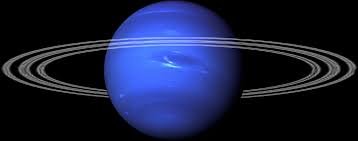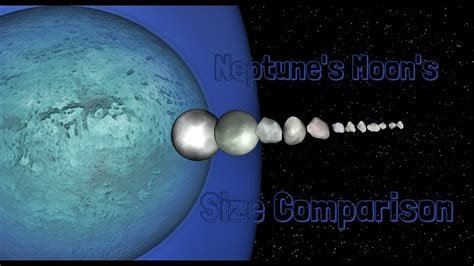The Blue Giant Planet NEPTUNE,Interesting Facts
Neptune's cloud cover has an especially vivid blue tint that is partly due to an as-yet-unidentified compound and the result of the absorption of red light by methane in the planets mostly hydrogen-helium atmosphere.So this planet looks blue and cause of such atmosphere,it known as BLUE GIANT.Neptune is the eighth planet from the Sun and last of the known planets. While it is the third largest planet with respect to mass, it is only the fourth largest in terms of diameter. Due to its blue coloration, Neptune was named after the Roman god of the Sea.It Discovered on September 23rd 1846 the planet Neptune was the first planet to have it’s existence predicted via a series of mathematical calculations before it was actually viewed through a telescope.

FACTS ABOUT NEPTUNE
• It takes Neptune 164.8 Earth years to orbit the Sun. On 11 July 2011, Neptune completed its first full orbit since its discovery in 1846.
• Neptune was discovered by Jean Joseph Le Verrier. The planet was not known to ancient civilizations because it is not visible to the naked eye. The planet was initially called Le Verrier after its discoverer. This name, however, quickly was abandoned and the name Neptune was chosen instead.
• Neptune is the Roman God of the Sea. In Greek, Neptune is called Poseidon.
• Neptune has the second largest gravity of any planet in the solar system – second only to Jupiter.
• The orbit path of Neptune is approximately 30 astronomical units (AU) from the Sun. This means it is around 30 times the distance from the Earth to the Sun.
• The largest Neptunian moon, Triton, was discovered just 17 days after Neptune itself was discovered.
• Neptune has a storm similar the Great Red Spot on Jupiter. It is commonly known as the Great Dark Spot and is roughly the size of Earth.
• Neptune also has a second storm called the Small Dark Spot. This storm is around the same size as Earth’s moon.

• Neptune spins very quickly on its axis. The planets equatorial clouds take 18 hours to complete one rotation. The reason this happens is that Neptune does not have a solid body.
• Only one spacecraft, the Voyager 2, has flown past Neptune. It happened in 1989 and captured the first close-up images of the Neptunian system. It took 246 minutes – four hours and six minutes – for signals from Voyager 2 to reach back to Earth.
• The climate on Neptune is extremely active. In its upper atmosphere, large storms sweep across it and high-speed solar winds track around the planet at up to 1,340 km per second. The largest storm was the Great Dark Spot in 1989 which lasted for around five years.

• Like the other outer planets, Neptune possesses a ring system, though its rings are very faint. They are most likely made up of ice particles and grains of dust with a carbon-based substance coating them.
• Neptune has 13 known moons. The largest of these moons is Titan – a frozen world which spits out particles of nitrogen ice and dust from below its surface. It is believed that Titan was caught by the immense gravitational pull of Neptune and is regarded as one of the coldest worlds in our solar system.
• Neptune has an average surface temperature of -214°C – approximately -353°F.
MORE INFORMATION AND FACTS ABOUT NEPTUNE
When scientific discoveries are made there is often a debate (sometimes heated) as to who deserves credit. The discovery of Neptune is one such example. Shortly after the discovery of the planet Uranus in 1781, scientists noticed that its orbit had significant fluctuations that were not expected.
In 1845, the English astronomer John Couch Adams completed his calculations as to the position of this unknown planet. Although he submitted his findings to the Royal Society (the leading English scientific organization), his work was met with little interest. However, a year later the French astronomer Jean Joseph Le Verrier made known his calculations that were strikingly similar to those of Adams. As a result of the two men’s independent estimates being so close, the scientific community took notice and began its search for the planet in the region of the sky Adams and Le Verrier had predicted. On September 23, 1846, the German astronomer Johann Gall observed the new planet near to where Adam’s calculations had forecasted and even closer to those of Le Verrier.
Le Verrier was initially given credit for the discovery. As a result, an international dispute arose, with one faction championing Adams and the other Le Verrier. This conflict, however, was not shared between the two men themselves. Eventually, the campaign for each side cooled, and both men were given credit.

Until the Voyager 2 spacecraft fly-by in 1989, little was known about Neptune. This mission provided new information about Neptune’s rings, number of moons, atmosphere and rotation. Additionally, Voyager 2 discovered significant features of the moon Triton. There are no official planetary missions scheduled to Neptune in the near future.
RINGS
Currently, Neptune is known to have thirteen moons. Of these thirteen only one is large and spherical in shape. This moon, Triton, is believed to have originally been a dwarf planet captured by Neptune’s gravitational field, and, thus, not a natural satellite of the planet. Evidence for this theory comes from Triton’s retrograde orbit of Neptune; that is, Triton orbits in the opposite direction that Neptune rotates. With a recorded surface temperature of -235° C, Triton is the coldest known object in the Solar System.
Neptune has three major rings – Adams, Le Verrier and Galle. This ring system is much fainter than that of the other gas giants. In fact, some of the rings are so dim that it was believed at one time that they were incomplete. However, images from the Voyager 2 fly-bys show extremely faint rings.

The planet Neptune is thought to have been formed through an initial increase in solid material forming the core of the planet followed by the accumulation of the surrounding gasses of helium and hydrogen within the nebula space of the early sun giving rise to the formation of the planet 10 million years later.

This post is very useful to out environment
Hi! I am a robot. I just upvoted you! I found similar content that readers might be interested in:
https://theplanets.org/neptune/
This planet so bigger than earth
Thanks ..... Good informations .... Jeep sharing and boosting our knowledge
Good job bro. Keep on sharing knowledge with us
Get lots of information from your post thank you keep it up
Good inforamtion about univers :)
Thnx bro...Just keep supporting me
intresting info
nice info
and i am done
UNBELIEVABLE U ARE